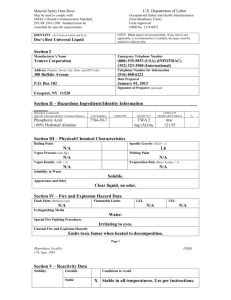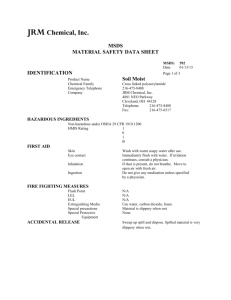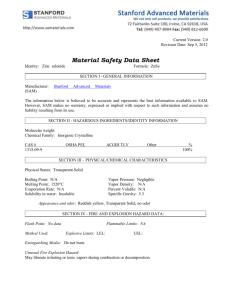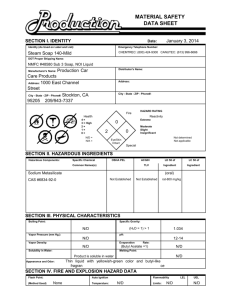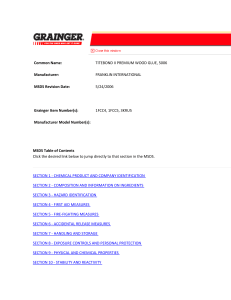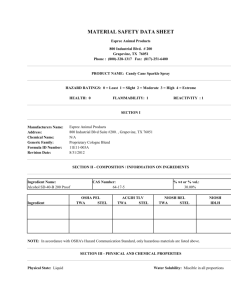product SDS
advertisement
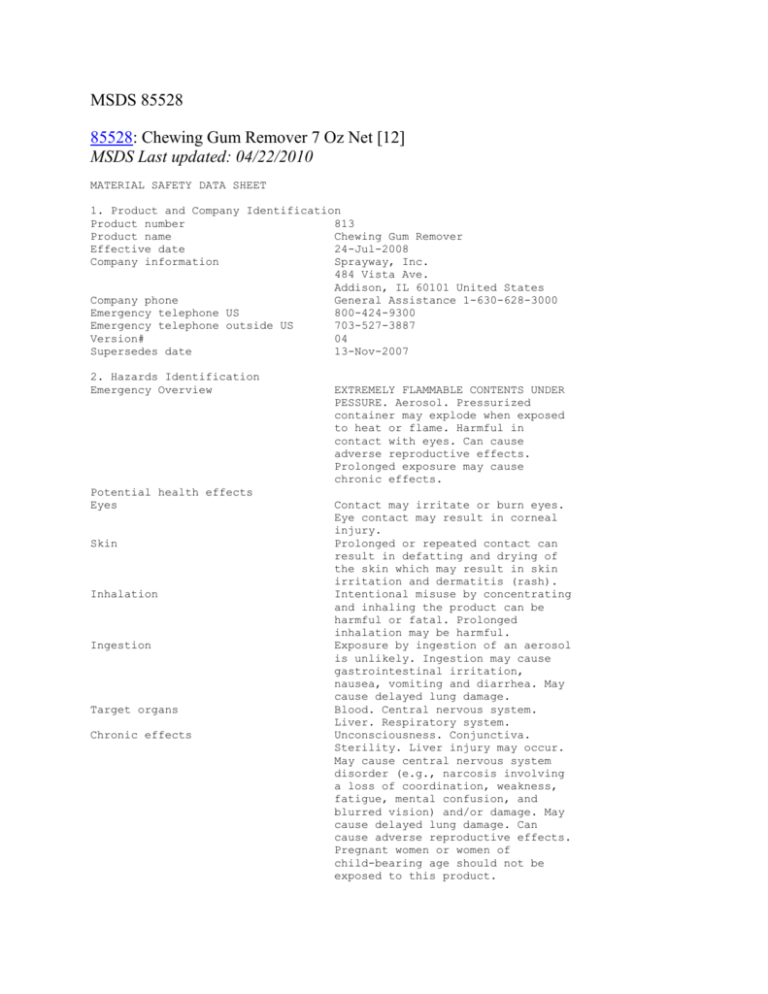
MSDS 85528 85528: Chewing Gum Remover 7 Oz Net [12] MSDS Last updated: 04/22/2010 MATERIAL SAFETY DATA SHEET 1. Product and Company Identification Product number 813 Product name Chewing Gum Remover Effective date 24-Jul-2008 Company information Sprayway, Inc. 484 Vista Ave. Addison, IL 60101 United States Company phone General Assistance 1-630-628-3000 Emergency telephone US 800-424-9300 Emergency telephone outside US 703-527-3887 Version# 04 Supersedes date 13-Nov-2007 2. Hazards Identification Emergency Overview Potential health effects Eyes Skin Inhalation Ingestion Target organs Chronic effects EXTREMELY FLAMMABLE CONTENTS UNDER PESSURE. Aerosol. Pressurized container may explode when exposed to heat or flame. Harmful in contact with eyes. Can cause adverse reproductive effects. Prolonged exposure may cause chronic effects. Contact may irritate or burn eyes. Eye contact may result in corneal injury. Prolonged or repeated contact can result in defatting and drying of the skin which may result in skin irritation and dermatitis (rash). Intentional misuse by concentrating and inhaling the product can be harmful or fatal. Prolonged inhalation may be harmful. Exposure by ingestion of an aerosol is unlikely. Ingestion may cause gastrointestinal irritation, nausea, vomiting and diarrhea. May cause delayed lung damage. Blood. Central nervous system. Liver. Respiratory system. Unconsciousness. Conjunctiva. Sterility. Liver injury may occur. May cause central nervous system disorder (e.g., narcosis involving a loss of coordination, weakness, fatigue, mental confusion, and blurred vision) and/or damage. May cause delayed lung damage. Can cause adverse reproductive effects. Pregnant women or women of child-bearing age should not be exposed to this product. 3. Composition/Information on Ingredients Components CAS# Percent n-Butane 106-97-8 60-70 Propane 74-98-6 20-30 Ethyl Alcohol 64-17-5 8-10 Non-hazardous and other components below reportable levels 0.0001-0.1 4. First Aid Measures Firs aid procedures Eye contact Skin contact Inhalation Ingestion. 5. Fire Fighting Measurers Flammable Properties Extinguishing media Suitable extinguishing media Protection of firefighters Protective equipment and precautions for firefighters. 6. Accidental Release Measures Personal precautions Immediately flush eyes with plenty of water for at least 15 minutes. Remove contact lenses, if present and easy to do. Get medical attention immediately. Immediately take off all contaminated clothing. Wash off with warm water and soap. Get medical attention if irritation develops or persists. Move to fresh air. Call a physician if symptoms develop or persist Rinse mouth. Get medical attention immediately. Do not induce vomiting without medical advice. If vomiting occurs naturally, have victim lean forward to reduce risk of aspiration. Do not use mouth-to-mouth method if victim ingested the substance. Induce artificial respiration with the aid of a pocket mask equipped with a one-way valve or other proper respiratory medical device. Containers may explode when heated. Vapor or gas may spread to distant ignition sources and flash back. Water fog. Foam. Dry chemical. Carbon dioxide (CO2). In the event of fire and/or explosion do not breathe fumes. Wear full protective clothing, including helmet, self-contained positive pressure demand breathing apparatus, protective clothing and face mask. Containers should be cooled with water to prevent vapor pressure build up. For massive fire, use unmanned hose holders or monitor nozzles; if this is impossible, withdraw fro area and let fire burn. Eliminate all igneous sources (no smoking, flares, sparks, or flames in immediate area). Stop leak if you ca do so without risk. Move the cylinder to a safe and open area if the leak is irreparable. Small Spills: Wipe up with absorbent material (e.g. cloth, fleece). Clean contaminated surface thoroughly. Methods for cleaning up 7. Handling and Storage Handling Pressurized container: Do not pierce or burn, even after use. Do not handle or store near an open flame, heat or other sources of ignition. Use only in area provided with appropriate exhaust ventilation. Do not use if spray button is missing or defective. Do not get this material in contact with eyes. Do not get this material in contact with skin. Avoid prolonged exposure. Level 3 Aerosol. Contents under pressure. Do not puncture, incinerate or crush. The pressure in sealed containers can increase under the influence of heat. Keep away from heat, sparks, and flame. Avoid exposure to long periods of sunlight. Store in a cool place. Keep in an area equipped with sprinklers. Keep out of the reach of children. Storage 8. Exposure Controls/ Personal Protection Exposure limits ACGIH Components CAS# TWA n-Butane 106-97-8 1000 ppm Propane 74-98-6 1000 ppm Ethyl alcohol 64-17-5 1000 ppm OSHA Components Propane CAS# 74-98-6 TWA 1000 ppm Ethyl alcohol 64-17-5 1000 ppm Personal protective equipment Eye/face protection Skin protection Respiratory protection 9. Physical & Chemical Properties Appearance Boiling point Color Flammability (HOC) Flash back STEL Not established Not established Not established CEILING Not established Not established Not established STEL Not established Not established CEILING Not established Not established Wear chemical goggles Protective gloves When workers are facing concentrations above the exposure limit they must use appropriate certified respirators. Compressed liquefied gas 1.4F (-17.2C) estimated clear colorless 41.9597 kJ/g estimated Yes Flash point Form Odor pH Physical State Pressure Solubility Specific gravity -156F (-104.4 C) estimated Aerosol Fruity Not applicable Liquid. 60-70 psig@70 Partially 0.57 estimated 10. Chemical Stability & Reactivity Information Chemical stability Risk of ignition. Stable at normal conditions Conditions to avoid Heat, flames and sparks Incompatible materials Isocyanates. Hazardous decomposition products May include oxides of nitrogen 11. Toxicological Information Acute effects Sensitization Chronic effects Reproductive effects Teratogenicity 12. Ecological Information Ecotoxicity 13. Disposal Considerations Disposal Instructions 14. Transport Information Department of Transportation (DOT) Basic shipping requirements Proper shipping name Hazard class Subsidiary hazard class Additional Information Packaging exceptions Packaging non bulk Packaging bulk IMDG Basic shipping requirements Proper shipping name Hazard class UN number Additional Information Acute LC50: 1538 mg/l/4h estimated, Rat, Inhalation Not expected to be hazardous by OSHA criteria Not expected to be hazardous by OSHA criteria Hazardous by OSHA criteria. Possible reproductive hazard. Can cause adverse reproductive effects-such as birth defects, miscarriages, and infertility. Not expected to be hazardous by OSHA criteria Ecological injuries are not known or expected under normal use. D001: Waste Flammable material with a flash point <140F Consult authorities before disposal. Contents under pressure. Do not puncture, incinerate or crush. If discarded, this product is considered a RCRA ignitable waste, Doo1. Dispose in accordance with all applicable regulations. Requirements Consumer commodity ORM-D None 156,306 156,306 None Aerosols 2.1 1950 Packaging exceptions Item Labels required Transport Category IATA Basic shipping requirements Proper shipping name Hazard class Un number Additional information: Packaging exceptions Labels required 15. Regulatory Information US federal regulations LTD QTY 5F None 2 Aerosols 2.1 1950 LTD QTY 2.1 This product is a "Hazardous Chemical" as defined by the OSHA Hazard Communication Standard, 29 CFR 1910.1200. CERCLA/SARA Hazardous Substances-Not applicable. OSHA Process Safety Standard: This material is not known to be hazardous by the OSHA Highly Hazardous Process Safety Standard, 29 CFR 1910.119. Occupational Safety and Health Administration OSHA 29 CRF 1910.1200 hazardous chemical yes CERCLA (Superfund) reportable quantity None Superfund Amendment and Reauthorization Act of 1986 (SARA) Hazard categories Immediate Hazard-Yes Delayed Hazard-No Fire Hazard-Yes Pressure Hazard-Yes Reactivity Hazard-No Section 302 extremely hazardous No substance Section 311 hazardous chemical Yes Inventory status Country(s) or region Inventory Name On inventory (yes/no)* China Inventory of Existing no Chemical Substances in China (IECSC) Europe European inventory of yes New and Existing Chemicals (EINECS) Europe Europe List of Notified yes Chemical Substances (ELINCS) Japan Inventory of Existing no New Chemical Substances (ENCS) Korea Existing Chemicals List no (ECL) United States & Puerto Toxic Substances yes Rico Control Act (TSCA) Inventory A "Yes" indicates that all components of this product comply with the inventory requirements administered by the governing country(s) State regulations U.S. - Pennsylvania-RTK (Right to Know) List Ethyl Alcohol 64-17-5 Present n-Butane 106-97-8 Present Propane 74-98-6 Present 16. Other Information HMIS® ratings Health: 1 Flammability: 4 Physical hazard: 0 Disclaimer The information provided in this Safety Data Sheet is correct to the best of out knowledge, information and belief at the date of its publication. The information given is designed only as guidance for safe handling, use, processing, storage, transportation, disposal and release and is not to be considered a warranty or quality speculation. The information relates only to the specific material designate and may not be valid for such material used in combination with any other materials or in any process, unless specified in the text. MSDS sections updated Hazards Identification: Emergency overview Handling and Storage: Storage Physical & Chemical Properties: Fire Fighting Measures Transport Information: Agency Name and Packaging Type/Transport Mode Selection Regulatory Information: United States The information contained in this MSDS was obtained from current and reliable sources, however, the data is provided without any warrenty, expressed or implied, regarding its correctness or accuracy. Since the conditions or handling, storage and disposal of this product are beyond the control of Imperial Supplies LLC, Imperial will not be responsible for loss, injury, or expense arising out of the products improper use. No warranty, expressed or inferred, regarding the product described in this MSDS shall be created or inferred by any statement in this MSDS. Various government agencies may have specific regulations regarding the transportation, handling, storage, use, or disposal of this product which may not be covered by this MSDS. The user is responsible for full compliance.


